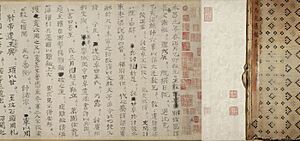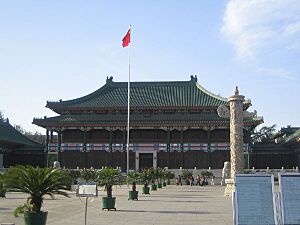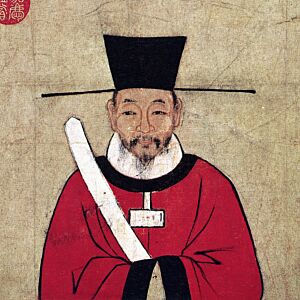Zizhi Tongjian facts for kids

A part of one of the original scrolls from the Zizhi Tongjian
|
|
| Author | Sima Guang and his team |
|---|---|
| Language | Classical Chinese |
| Subject | History of China |
|
Publication date
|
1084 |
| Media type | Scrolls |
|
Original text
|
Zizhi Tongjian at Script error: The function "name_from_code" does not exist. Wikisource |
The Zizhi Tongjian is a huge history book from ancient China. It was finished in 1084 during the Northern Song dynasty. This book tells the story of Chinese history for nearly 1400 years. It covers events from 403 BC to 959 AD.
The book is made up of 294 scrolls, which are like chapters. It has about 3 million Chinese characters. The title means "Comprehensive Mirror in Aid of Governance." This means it was meant to be a guide for rulers.
In 1065, Emperor Yingzong of Song asked his official, Sima Guang, to create this big history project. Sima Guang was given money and could choose his own team. It took them 19 years to finish the book. In 1084, they gave it to Emperor Yingzong's son, Emperor Shenzong of Song.
The Zizhi Tongjian was very popular. It became a super important book for both scholars and regular people. Historians like Endymion Wilkinson said it was a great reference. He noted it had a huge impact on later Chinese history writing.
Contents
What's Inside the Zizhi Tongjian?
The main part of the Zizhi Tongjian is a story of Chinese history, told year by year. It fills 294 scrolls. The book covers many important times in Chinese history. These include the Warring States, Qin, Han, Three Kingdoms, Jin, and Tang dynasties.
Besides the main story, there are two other sections. These are 30 scrolls of 'tables' (目錄; mùlù). There are also 30 scrolls of 'critical analysis' (考異; kǎoyì).
How the Book Was Written
Sima Guang chose a different way to write history. Most Chinese history books at the time focused on rulers' lives and officials' biographies. This was called the 'biographical style' (紀傳體; jìzhuàntǐ).
Sima Guang instead used a 'chronological style' (編年體; biānniántǐ). This means he told events in the order they happened. He wanted to make history easier to understand.
Sima Guang explained his idea to the Emperor. He said that old history books were too long and confusing. He wanted to write a history that rulers could use. It would show them how dynasties rose and fell. It would also show what made people happy or sad. He hoped it would teach good lessons and warn against bad choices.
Sima Guang had a team of helpers. His main assistants were Liu Shu and Liu Ban. Later, Fan Zuyu also joined the team. They used 322 different sources to write the book.
Other Books Based on Zizhi Tongjian
Many other books were created from the Zizhi Tongjian. In the 1100s, Zhu Xi made a shorter version. It was called the Zizhi Tongjian Gangmu.
This shorter version was even translated into the Manchu language. This happened because the Qing Kangxi Emperor asked for it. Later, a French missionary named Joseph-Anne-Marie de Moyriac de Mailla translated the Manchu version into French. His 12-book translation was published after he died.
Other scholars have also studied and commented on the Zizhi Tongjian. A historian named Hu Sanxing added his own notes and thoughts. The philosopher Wang Fuzhi wrote a book called Comments After Reading the Tongjian.
Some parts of the Zizhi Tongjian have also been translated into English. For example, historian Rafe de Crespigny translated chapters about the Han dynasty.
What Periods of History Does It Cover?

The Zizhi Tongjian has 294 chapters. Each chapter covers a specific time period in Chinese history. Here's how many chapters are about each dynasty:
- 5 chapters – Zhou (1046–256 BC)
- 3 chapters – Qin (221–207 BC)
- 60 chapters – Han (206 BC – 220 AD)
- 10 chapters – Wei (220–265)
- 40 chapters – Jin (266–420)
- 16 chapters – Liu Song (420–479)
- 10 chapters – Qi (479–502)
- 22 chapters – Liang (502–557)
- 10 chapters – Chen (557–589)
- 8 chapters – Sui (589–618)
- 81 chapters – Tang (618–907)
- 6 chapters – Later Liang (907–923)
- 8 chapters – Later Tang (923–936)
- 6 chapters – Later Jin (936–947)
- 4 chapters – Later Han (947–951)
- 5 chapters – Later Zhou (951–960)
See Also
- Culture of the Song dynasty
- History of the Song dynasty
- Records of the Grand Historian


